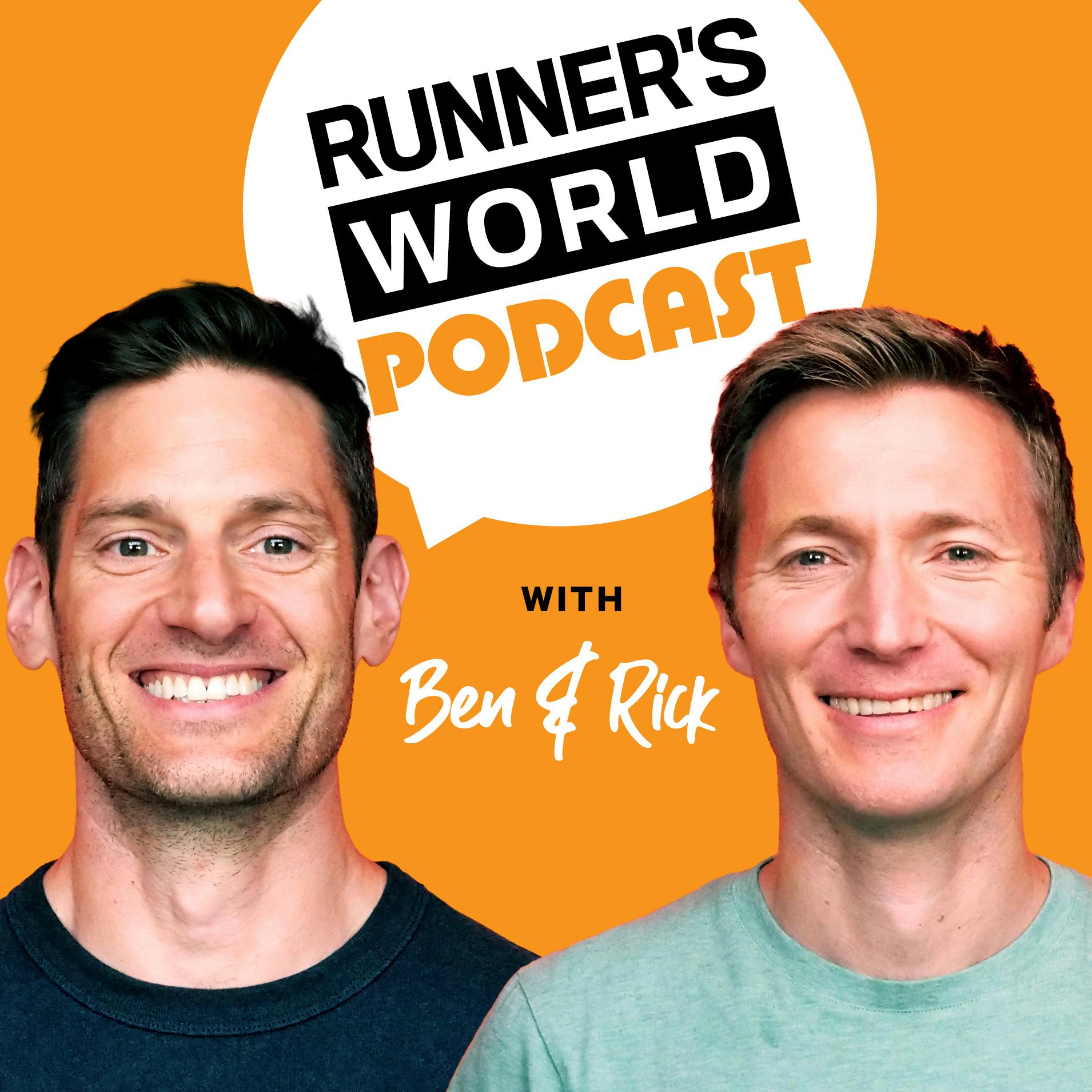
Brian's Run Pod
Welcome to Brian's Run Pod, the podcast where we lace up our running shoes and explore the exhilarating world of running. Whether you're a seasoned marathoner, a casual jogger, or just thinking about taking your first stride, this podcast is your ultimate companion on your running journey.
Join us as we dive deep into the sport of running, covering everything from training tips and race strategies to personal stories and inspiring interviews with runners from all walks of life. Whether you're looking to improve your race times, stay motivated, or simply enjoy the therapeutic rhythm of running, Brian's Run Pod has something for every runner.
Brian's Run Pod
The Power of Perseverance: Tom Gaymor's Transformation part one
What if you could uncover the secrets behind the physical demands of motorsports and the journey of an ex-racing driver? Join us for an insightful conversation with our old friend, Tom Gaymor, an ex-racing driver, current motorsport commentator, as we explore his passion for sports and his incredible journey in the world of motorsports.
Discover how Tom's connection to his granddad, a doctor and open water swimmer, ignited his love for sports and opened doors to the world of motor racing. Follow Tom's transition to motorsport, starting with karting at Sandown Park. We delve into the evolution of motor racing, its facilities, and the costs associated with the sport today.
But it's not all about speed and adrenaline. Tom opens up about the challenges he faced with a back injury sustained during his racing career. We discuss the pain and discomfort of his procedures, as well as the story of England rugby player Jason Lendon, who experienced a similar injury. This episode is a must-listen for any sports enthusiasts, filled with inspiring stories and valuable insights into the world of motorsports.
Lucy Tomlinson Christmas Offer for Welcome Pilates
Merili Freear running author promotes her new book
Fitz Koehler's new Book "You Supercharged".
Lisa Jackson - "Still Running After All These Tears".
Brian's Run Pod has become interactive with the audience. If you look at the top of the Episode description tap on "Send us a Text Message". You can tell me what you think of the episode or alternatively what you would like covered. If your lucky I might even read them out on the podcast.
Instagram
Welcome back to Brian's Run Pod. Before I introduce you to Tom Gamer, i thought I would explain that I have split this interview into two parts. The first part talks about Tom's experience of sport when growing up and how he got into motorsport. In the second part of this interview, which will come out in a couple of weeks, we talk about his injury in the process he went through through post-recovery. I just thought I'd also take this opportunity to say that I'm interviewing a friend of my wife, colleen McKenna. She is a very enthusiastic runner and has run regularly for most of her life. That interview I've also split into two parts. We talk about how, from being a gymnast at school, she transitioned into becoming a runner. Plus, we talk about what are the training techniques and tech she uses for her runs.
Speaker 1:I really, really hope you enjoy these interviews as much as I did. So you're thinking about running, but not sure how to take the first step. My name's Brian Patterson and I'm here to help, and welcome to Brian's Rumpod Music. Welcome to Brian's Rumpod. And today we're going to be talking to an old friend of mine, tom Gamal, ex-racing driver, current motorsport commentator and an ex-model, having come late into motorsport compared to today's standards. He raced locally at Sandau Park for stroke carting and then went on to race and live in France. Now we're going to be asked. Now you're going to be asking what this has to do with running.
Speaker 2:Well.
Speaker 1:I feel that it's always helpful to get a different perspective of how other professional sports people have dealt with career defining, injuries And also maybe you know their way of training. So welcome to the podcast, tom. Thanks for agreeing to speak to me tonight. Firstly, i just want to start off with what do you like as sports at school?
Speaker 2:Yeah, it's a really good question. I mean, i love being active and it wasn't until I got a bit older and realized that we all learn in different ways. But I'm a very sort of kinesthetic learner, a very visual learner, And you know that lent itself to sort of being out and about. So I was always looking out the window and longing for break time and PE and games And then when the rain came, that frustration of having to play Hangman and being forced into not leaving the classroom was my kind of hate. So you know, i loved being active as a young kid And you know I'm 41 now.
Speaker 2:But even when I was younger we had computers and you know the Sega Mega Drives and the Super Nintendo's of the day and the Commodore Amiga who's old enough to remember what a Commodore Amiga is? But you know I didn't really have any games, consoles. I was always outside and you know, from a young age I always had a bat in my hand, love cricket, love rugby. And then, as I got a bit older, motorsports came into my life as well.
Speaker 1:What's got you interested to segue into that? What got you into it? Because in motorsports, because I know I was listening to a podcast about with Scott Speed and he said his dad was a massive F1 fan and loves Schumacher. And I mean, was there someone in your family who was really mad about motorsport or Formula One?
Speaker 2:Well, do you know what The whole tie into sport? I was very fortunate. My granddad was a wonderful swimmer and he loved open water swimming and you know tried to swim the channel tried to. you know he was always up at Lake Windermere, was always out, you know, swimming in his 80s And he was a doctor. He was the honorary RFU doctor, england Rugby Doctor as well.
Speaker 2:So I grew up around that professional sporting environment and I used to get picked up from school and sometimes go to Twickenham and watch the England team train, captain's day and that kind of stuff. So I you know I had that and you're probably wondering what the link is. but he also had a very good connection, a chat called David Price, who we've just lost, actually 14 weeks ago, and David was a big name in the motorsport world. you know he ran Brabant for Bernie. He was instrumental when it came to success at Le Mans for various different manufacturers and had his time at Benetton and various other things in the sport.
Speaker 2:And I was invited, along with my granddad, to go and visit David at the sort of 10th or age of 10. And I never looked back because you know we all have, or the majority of us had, the opportunity to play those grass roots or the sports at grass root level that I mentioned football, cricket, rugby. But motorsport isn't something that many people come across And I was very fortunate to have that experience And from that day on it just the smell, the sight, the sound. it was so special that it was a dream of mine from that moment to try and progress.
Speaker 1:Right, right, right. And then, as I said, you know in the intro, then you did you kind of immediately start looking as to what was local, like you said you know, going to sand down and then trying that out, Or was there? was there something that happened before then?
Speaker 2:Well, i left the modelling behind. If that's what you're, we have to touch on that. I wasn't essentially model. My mum was in that, in that space, and dragged me along on numerous different shoots, so I think I was exploited as a child and all right, okay, too much The funds that came away, but then.
Speaker 2:But yeah, so I left the modelling behind and then did go and find my local car venue and standout park was that and there was a wonderful chap there called Andrew Crichton, who actually runs all the on track activity at Anglesey now, which is a rather unique circuit on the sort of north west coast of Wales, and he, you know, he had a wonderful way of introducing the sport to people like myself, to my family, to people that didn't know much about it.
Speaker 2:He created that trust, his face, and you know we all went racing with a smile on our faces until you lost, of course, which was you have more bad days in motorsport than you have good days. I wish someone had talked with that at the beginning rather than now. But you know, we had that in-car club and everyone got together and raced every last Sunday of each month And it was a wonderful time And there were some really good young peddlers that came out of that And that sort of progressed into, you know, traveling around the South of England and then a bit of personal stuff as well, as I got a bit older.
Speaker 1:Right, right, right. And so I suppose it doesn't really come into it at that stage where you feel that you know keeping fit and carting are kind of you know they're two separate things, sort of thing. I suppose at that stage, i mean, i speak because you're quite young, you- know what They are And they aren't.
Speaker 2:What you learn very quickly is it's very physical And carting is very, very physical And the machinery that you're in is very different to the arrive and drive equipment that you might experience as an adult. And the carts have a huge amount of grip And you learn quickly that you're not strong enough to be able to do what you want to do. So the fitness comes in at a very early age And a lot of that to a certain extent match fitness. But you know, when you move up the classes, when you know when you get the grip, you know the grip that I'm talking about is enough to crack your ribs on the seat today. So when I say crack your ribs, think of a hardball there And if you bang that with a spoon it's going to. It's going to crack. That's what you're getting on your ribs on the seat stage. So you've got huge rib protectors that come in, oh yes, otherwise they'll just break. And you know when you're talking about 11, 12 year old kids breaking their ribs, just that's not even in a crash. So you know there's a huge amount of force on your neck, through your forearms and against the sort of middle part of your torso. So you have to start to really look at your fitness And you know I haven't done that before.
Speaker 2:I was fit, i was active, but I it wasn't. You know something that I obsessed about, or you know there wasn't a professional environment for me, it was what you did at school. You were just active, you did your sort of gymnastics, your PE and your rugby and your cricket, and you had fun doing it. You know you weren't working with personal trainers and strengthening certain areas of your body And you know, looking at your hydration and your nutrition. But that's very much what you start to do in the carting world And it's not too dissimilar to being a jockey as well. Weight is a huge aspect. You cannot afford to be overweight, and what I mean by overweight is over the weight limit. They have a, you know, a minimum weight And you don't want to be over that minimum weight because you're going to start losing time.
Speaker 1:Mm-hmm, so kind of moving it on. what kind of forced you into? or what was that point where you think, right, i'm going to take the leap, and then I need to kind of either go somewhere that will teach me professionally, because we, as we said, you went to live and drive in France. Yes, what sort of prompted that?
Speaker 2:Well, i was listening you know I was listening to a podcast the other day, actually just before I talk about what prompted it And it was a football player And he was talking about when he became a professional. And a lot of people take that turn and think, well, that's the first day he signed a professional contract. And he was alluding to the fact that actually he didn't have the maturity or the application on the day that he signed his professional contract to act and behave, in his eyes, in a professional way. So it wasn't until he got the right people around him and the right manager that he really doubled down and became what he sees now as a professional. And it was the same.
Speaker 2:For me, it wasn't until I went to France and the FFSA, which is the National Governing Body. They have a, you know, wonderful setup there. I lived in Le Mans. I was under the guidance of Henri Pescarola, who is France's most successful driver when it comes to Le Mans. The Le Mans 24 hour is such a big event there And you know I had some wonderful people around me And you know Henri had a wonderful motor sport career in F1 and sports cars and to be surrounded by those people and you know to have teammates that were world karting champions and stuff like that.
Speaker 2:You go from very quickly living in a bubble in southwest London to crikey. I'm living in Europe. Now I'm away from home, i've got some of the best people in the world around me, i've got a real opportunity And it was that sort of Eureka moment where you just became a different person overnight because you had to And you had to realise that even it the tender age of 17, that this was an opportunity that you couldn't waste and you had to take control of every parameter that you had when it came to performance and maximize it. But yeah, going back to your question, i'm sure we'll touch on that in a minute.
Speaker 2:But going back to your question, how did France come about? I was lucky enough to be chosen through a national competition that takes sort of all the car drivers in the country at that time and you go through a shootout at Silverstone and then the top 10, i think it is out of the sort of 100 or so that ends up go to Le Mans and then you do a two day shootout at Le Mans in Formula Renault cars and then they take the top two and the top two, get a fully funded drive in Europe, funded by Renault, funded by ELF, and you compete in European Formula Renault and French Formula Renault and do various different things and live with foreign racing drivers. There's loads of drivers from all over the world that come and join you and it was an amazing experience at the age of 17.
Speaker 1:Right, okay, and because I know, is there another school at Magny Core? Is that where Damon Hill went? Is that right?
Speaker 2:Yeah, so Magny Core, and it's like anything in life. Even what I did now at the affiliaries is sort of eroded away, and what Damon did at Magny Core. Things evolve and change and I'm going back two decades now that I missed by yesterday, but I'm sure you're aware those 20 years just disappear in the blink of an eye. And then there's other things that are up and running now and the sports come on as well. We can't hide away from that, the sort of the facilities. I went to a goldmine facility in Lafayette but there's other goldmine facilities now because the sport's grown and so has it evolved, and there's pop-ups all over the place and teams now that do a wonderful job F1 Junior programs. They've grown, so there's lots of opportunity for young drivers, whereas there wasn't so much in the way of opportunity when I was younger. You had to sort of find your own way.
Speaker 1:I mean, what you hear a lot about these days is kind of it's an expensive sport, but obviously you've managed to find an avenue through your talent or lack of it.
Speaker 2:But now it's an expensive sport and from an ethical perspective, it pains me, it pains a lot of people that are in the sport because actually it's not as accessible as it is, and I was very fortunate to be brought up in an environment that meant that I could go karting and I could do things away from school, and not many kids have that opportunity to do those extracurricular activities that cost that amount of money. I was never going to be able to fund any more, and so going to racing in Europe and having that financial support from Elf was a blessing for me because it kickstarted my career. And then, with some success, you have the opportunity to build some momentum then and build some investment and some partners and try and get some sponsorship on board.
Speaker 1:So again, did they go through some form of fitness program with you, and, if so, what was it that you were doing?
Speaker 2:Well, the person in the trainer there smoked about 40 jitans a day. He used to stand there in a white vest with a jitan in his mouth and he had a wonderful way about it, but he worked on it really hard and then you didn't want to let him down, you didn't want to let yourself down, but you had around you your teammates and when you're in motorsports, very solitary environments and the one rule is you've got to beat your teammate and so when you're training and racing with these people, there's that motivation every single time you're in the gym to be better than they are. And when you, you know, whatever it is that you're doing, when you see pain on their faces, you feed off that. When you're dying inside, but you see they're dying inside, it gives you more. You know, and it was a very competitive environment, but that Doggy dog type. Yeah, you know that. But we were good friends as well. But we had that mutual respect for each other and we knew that in in those competitive spaces we were ruthless and we wanted it and everyone had the same mindset. But that that created a sort of a mutual respect for each other, you know, and there were times where you might crash into each other and not talk for a bit, and that might go on for a week or two, but you know. But these things happen and you know, we were growing as young individuals as well, so learning our way, learning what worked for us, what was the best mindset. But yeah, we were super competitive and we spent a huge amount of time training because In motorsport you have a very high heart rate for a very, very long period of time.
Speaker 2:So if the event is two hours, 120 minutes, then you're going to be up at around 150, 160 beats per minute for that two hour period. So you need to be very fit in terms of being able to manage the stress that your heart's under. But also you're under a huge amount of G-force as well. So there's a lot of stresses on the body. And the final one is heat. So if it's 30 degrees outside, then it's going to be about 40 degrees in the single seater. So I raised like a little formal one car, if you like, but the heat that's around you in the car.
Speaker 2:You're sitting essentially on an engine And so it's around 40 degrees, and then you're wearing Nomex underwear, you're wearing a triple air Nomex suit, you've got a balaclava on. You've got a helmet on, there's no airflow, you're sitting in a hole, which is an aerodynamic nightmare. So they direct the airflow away from you. So you'll see drivers putting their hands up when they come into the pit lane just to get some air down their sleeves or whatever it is. But so you're in 40 degrees, which is not too far away from a scenario. You've got a high heart rate of like 150, 160. And your core body temperature is pushing up to 40 as well. So your core body temperature is right on the edge of what is humanly possible.
Speaker 2:People will go to hospital to eat if they had that sort of reading, and so it's a really, really, really tough environment. And then you've got to be hugely strong in certain areas to be able to turn the wheel, to hold your head up in certain corners. You look at IndyCar. I commentate on IndyCar at the moment. They've just been to Barber Motorsports Park in Alabama, which is a wonderful road course, but there's corners there where the load when the car compresses, is actually unraveling the lock And you haven't got the physical strength to hold the load. So you're looking at about 35 kilos, which is a huge amount If you think that's one hand really pushing that up. If it's a right hand, corner your left hand. So it's a lot of load And people. Just it's very hard to simulate what that load feels like and that environment feels like. So that's, in a nutshell, why you've got to be fit.
Speaker 1:Because I remember, i mean because I knew you when you were at David Lloyd down the road, but I remember you had this kind of neck brace thing, i said, on the nose. it did look a bit on the kinky side. It was an alternative, wasn't it?
Speaker 2:I wasn't a member of any extra cricket clubs, i can assure you. But it's a big sort of leather strap and it's got different straps, it goes over your head and it's attached to chain. So, just to put everyone's imagination at rest, that's what it is. But yeah, it did. It got a few strange looks. But you can hook that up to the A-frame and start working on the sternomastoid, the fastest growing muscle in the body, apparently.
Speaker 2:The sternomastoid you can work on It's actually the back of your neck. So when you hit the brakes it's five, five Gs. So five times you've got a helmet on your head as well. So, whatever your head weighs, however many kilos, that is, i don't know, a couple of kilos plus the helmet, whatever. So it's five times that. So it's anything up to 40 kilos. Now if I just dropped a 40 kilo dumbbell on the bottom of a chin strap, it would just rip your chin down to your chest. And that's very much the sensation every time you're braking And when you first make a step up the classes.
Speaker 2:Because as you go up from I don't know, from the Renault, to form the three, to form the two, whatever, there's more and more load. The cars carry more G-force, they carry more load And so the sort of forces on your body grow. And when you first do the day in the car, you get to lunchtime you're like I can't keep my head up Every time I hit the brakes, my chin's pressed to my chest and it's just an absolute nightmare. It's a bit better with the hand system that, because you can cheat and do the tight and the tethers, but then you know and that's why you have that neck In my day.
Speaker 2:Yeah, that's why you have that neck contraption, because it's the worst feeling not putting the work in And I'm sure you know people listening to this or people running when you, when you, when you go on race. You need to trust the process. You need to trust that you prepared, you need to trust that you put the work in, and there's nothing worse than than not doing that. It's like going and doing an exam and not doing the revision, that you're full of trepidation beforehand, and that's what it feels like in a race as well. If you're not fit or you're injured or whatever it is, there's loads of trepidation before the event. Because you think I'm not going to make this.
Speaker 1:Yeah, yeah, yeah, so okay. so a lot of neck exercises, obviously quite a lot of core, core work.
Speaker 2:Yeah, lots of core, especially now I've got a metal back.
Speaker 1:Yes, yeah, we'll come on to that later And I know you're remember you're quite good swimmer, did you? did you find that that help as well?
Speaker 2:And I mean, i know it's a swimming form of kind of that means good for me because it's low impact and you know, naturally I go well in the pool. So I've been out in the open water today And I'm just I'm just coming back from a shoulder injury. I've got golfers elbow pause swimming, if that makes any sense, but then. But yes, i've been out in the outdoor pool today not my outdoor pool, the Hampton outdoor pool And I love swimming And I think swimming's great because you know you can regulate your breathing. It's a bit like being in a in a single seat. So so when you, when you're in a high speed corner, you might have a long high speed corner into a high, into a high speed braking zone. That could be three seconds where you can't breathe. So swimming is quite good because that a rovid.
Speaker 2:Yeah, you have the whole you know you can't breathe, through the high speed corner, then into the braking zone you can't breathe And it's a set, is simulated in swimming.
Speaker 1:So did you. I just want to sort of cut to the the sort of the injury Did you have the back problem? Was this kind of like an inherited back issue or it was?
Speaker 2:But I didn't know about it, it was undone. I had something called a spondylolisesis, which is really common. I think it don't quote me on this, but I think sort of 20% of the the world's population have a spondylolisesis is where the bone doesn't form properly in the lumbar right, forms as the cartilage, and so you might not have complete what they call bony union there sort of around L five s one, and it leads to localize back pain and stiffness and irritation, that kind of thing in and around the local area. And so I had that. But I, you know, you have that every time you're in the car. As I said, it's a brutal environment, so everything hurts. So I wasn't, you know, too symptomatic And then and then obviously I crashed And if you have all of those forces go through that area, it crumbled the, the, the cartilage away a little bit.
Speaker 2:So I didn't have that bony union. So essentially my back was not as secure as it is it needed to be in terms of what I could have sneezed, and something went wrong, you know. So it was straight into have the framework inserted around the vertebrae and then bone grass from my pelvis so deep into my pelvis, bone grass to build around the screws And that's really painful. If anyone's ever had a bone grass, especially from deep within the pelvis. Jason Lendon had one for his neck injury. The the England rugby player, and he said it brought him to tears. So when he said that to me, i wasn't too I wasn't too enamoured with what was to come, because if it brought him to tears it was going to ruin me.
Speaker 1:But then he's a lovely guy. I don't remember. I just talked to him. Yeah, used to come to David Lloyd. Yeah, he used to come to David Lloyd. Yeah, he used to.
Podcasts we love
Check out these other fine podcasts recommended by us, not an algorithm.

Life Changing
BBC Radio 4
Tech Life
BBC World Service
Runner's World Podcast
Runner's World UK
Buzzcast
Buzzsprout
Newscast
BBC News
Understand
BBC Radio 4
Cyber Hack
BBC World Service
Ghost Story
Wondery | Pineapple Street StudiosDiz Runs Radio: Running, Life, & Everything In Between
Join Denny Krahe, AKA Diz, as he talks with a variety of runners about running, life, and everything in between.
Uncharted with Hannah Fry
BBC Radio 4
The Global Story
BBC World Service
The Coming Storm
BBC Radio 4
Lives Less Ordinary
BBC World Service
Do Epic Shit Today Podcast
Hannah Mulhern
The Rest Is History
Goalhanger
